Polygon Formula – Definition, Symbol, Examples
Last Updated :
19 Feb, 2024
Polygons are closed two-dimensional shapes made with three or more lines, where each line intersects at vertices. Polygons can have various numbers of sides, such as three (triangles), four (quadrilaterals), and more. They exemplify the basic principles of geometry, showcasing different configurations and possibilities.
Polygon Definition
A polygon is a two-dimensional, closed shape with three or more straight sides. The name of a polygon indicates how many sides it has. For example, a triangle has three sides and a quadrilateral has four sides.
Polygon Shape Characteristics
Polygons have the following characteristics:
- Closed shape: Polygons are closed shapes, meaning they have no open ends.
- Plane shape: Polygons are made of straight lines.
- Two-dimensional: Polygons have length and width, but no other dimensions.
- Interior angles: Polygons have angles inside them. A regular polygon has all its interior angles equal to each other.
- Exterior angles: The exterior angle is the supplementary angle to the interior angle. The sum of the exterior angles of a polygon must be 360°.
Polygon Formula
Different polygon formulas where “n” is Number of Sides, “s” is Length of Each Side, and “l” is Apothem Length.
| Property |
Formula |
| Sum of Interior Angles of a Polygon |
(n-2)×180° |
| Interior Angle of a Regular Polygon |
(n-2)×180°/n |
| Exterior Angle of a Regular Polygon |
360°/n |
| Perimeter of an n-sided Regular Polygon |
n × s |
| Area of an n-sided Regular Polygon |
(n × s × apothem)/2 |
| (Perimeter × apothem)/2 |
| (l/2)tan(180°/n) |
Types of Polygons
Below are some types of polygons based on the number of sides of a polygon,
Number of sides
|
Polygon’s name
|
Figure
|
|
3
|
Triangle
|
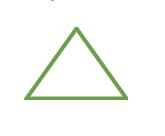 |
|
4
|
Quadrilateral
|
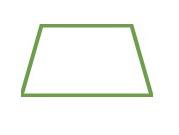 |
|
5
|
Pentagon
|
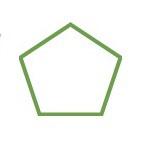 |
|
6
|
Hexagon
|
 |
|
7
|
Heptagon
|
 |
|
8
|
Octagon
|
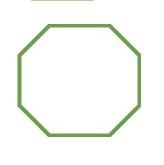 |
|
9
|
Nonagon
|
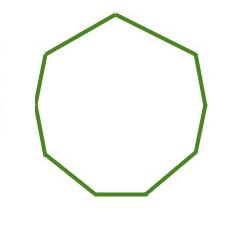 |
|
10
|
Decagon
|
 |
Based on measure of angles and the sides of a polygon, they are classified into the following types
- Regular polygon
- Irregular polygon
- Concave polygon
- Convex polygon
- Equilateral polygon
- Equiangular Polygon
Regular polygon
A polygon is said to be a regular polygon if it has all the interior angles and the sides are of the same measure.

Examples of Regular Polygons
Irregular polygon
A polygon is said to be a regular polygon if it has all the interior angles and the sides have different values.

Examples of Irregular Polygons
Concave polygon
A concave polygon is a polygon that has at least one interior angle greater than 180 degrees, i.e., a reflex angle.

Examples of Concave Polygons
Convex polygon
A convex polygon is a polygon that has all the interior angles of a polygon less than 180 degrees.

Equilateral Polygon
An equilateral polygon is a polygon whose all sides measure the same.

Examples of Equilateral Polygons
Equiangular Polygon
An equiangular polygon is a polygon whose all angles measure the same.

Examples of Equiangular Polygons
Properties of Polygon
- Sum of the interior angles of a polygon depends on the number of sides.
- Number of vertices in a polygon is equal to the number of sides.
- Sum of the exterior angles in any polygon is always 360 degrees.
- A polygon can be either convex (all interior angles are less than 180 degrees) or concave (at least one interior angle is greater than 180 degrees).
- A polygon is regular if all its sides and angles are congruent (equal); otherwise, it’s irregular.
Solved Examples on Polygon Formula
Let’s solve some example problems based on the Polygon Formulas.
Example 1: Calculate the perimeter and value of one interior angle of a regular heptagon whose side length is 6 cm.
Solution:
Polygon is an heptagon. So, number of sides (n) = 7
Length of each side (s) = 6 cm
We know that,
Perimeter of the heptagon (P) = n × s
P = 7 × 6
= 42 cm
Now, find each interior angle by using the polygon formula,
Interior Angle = [(n-2)180°]/n
= [(7 – 2)180°]/7
= (5 × 180°)/7
= 128.57°
Therefore, perimeter of the given heptagon is 42 cm and the value of each internal angle is 128.57°.
Example 2: Calculate the measure of one interior angle and the number of diagonals of a regular decagon.
Solution:
Polygon is a decagon. So, number of sides (n) = 10
Now, to find each interior angle by using the polygon formula,
Interior Angle = [(n-2)180°]/n
= [(10 – 2)180°]/10
= (8 × 180°)/10
= 144°
We know that,
Number of diagonals in a n-sided polygon = n(n-3)/2
= 10(10 – 3)/2
= 10(7)/2 = 35.
Therefore, value of each internal angle of a regular decagon is 144° the number of diagonals is 35.
Example 3: Calculate the sum of interior angles of a hexagon using the polygon formula.
Solution:
Polygon is a hexagon. So, number of sides (n) = 6
We know that,
Sum of interior angles of a polygon = (n-2)×180°
= (6-2)×180°
= 4×180° = 720°.
Hence, sum of interior angles of a hexagon is 720°.
Example 4: Calculate the measures of one exterior angle and the perimeter of a regular pentagon whose side length is 9 inches.
Solution:
Polygon is a pentagon. So, number of sides (n) = 5
We know that,
Length of each side (s) = 9 inches
We know that,
Perimeter of the pentagon (P) = n × s
P = 5 × 9
= 45 inches
Each exterior angle of a regular polygon = 360°/n
= 360°/5 = 72°.
Hence, measures of one exterior angle and the perimeter of a regular pentagon are 72° and 45 inches, respectively.
Polygon Formulas- FAQs
What do we mean by the Polygon?
Polygon is a 2-D closed structure that is made up of three or more straight lines. A polygon consists of a minimum of three sides. Each line segment intersects with another line segment only at the vertex of Polygon. Polygon can be classified on the basis of angles. Some examples of polygons are triangles, squares, pentagons, hexagons, etc.
How Many Types of Polygon are there?
On the basis of the measurement of angles and the sides of a polygon, a polygon can be classified into:
- Regular Polygon: The interior angles and the sides of the polygon are equal.
- Irregular Polygon: The interior angles and the sides of the polygon are not equal.
- Convex polygon: The interior angles of a polygon are strictly less than 180°.
- Concave Polygon: Polygons have one or more interior angles which are greater than 180°.
What are Properties of a Polygon?
Some important properties of the polygon are:
- Sum of all the exterior angles of a polygon is always equal to 360°
- If at least one of the interior angles of a polygon is greater than180°, it is termed a concave polygon.
- If all the angles of a polygon are less than 180° then it is a convex polygon.
What are the polygon from 1 to 20?
Following are the names of polygons with sides ranging from 1 to 20:
- Monogon (1 side)
- Digon (2 sides)
- Triangle (3 sides)
- Quadrilateral (4 sides)
- Pentagon (5 sides)
- Hexagon (6 sides)
- Heptagon (7 sides)
- Octagon (8 sides)
- Nonagon (9 sides)
- Decagon (10 sides)
- Undecagon (11 sides)
- Dodecagon (12 sides)
- Tridecagon (13 sides)
- Tetradecagon (14 sides)
- Pentadecagon (15 sides)
- Hexadecagon (16 sides)
- Heptadecagon (17 sides)
- Octadecagon (18 sides)
- Nonadecagon (19 sides)
- Icosagon (20 sides)
Like Article
Suggest improvement
Share your thoughts in the comments
Please Login to comment...